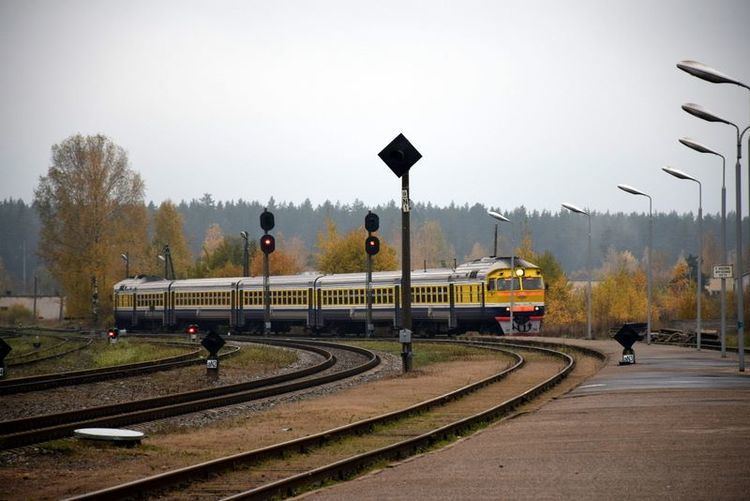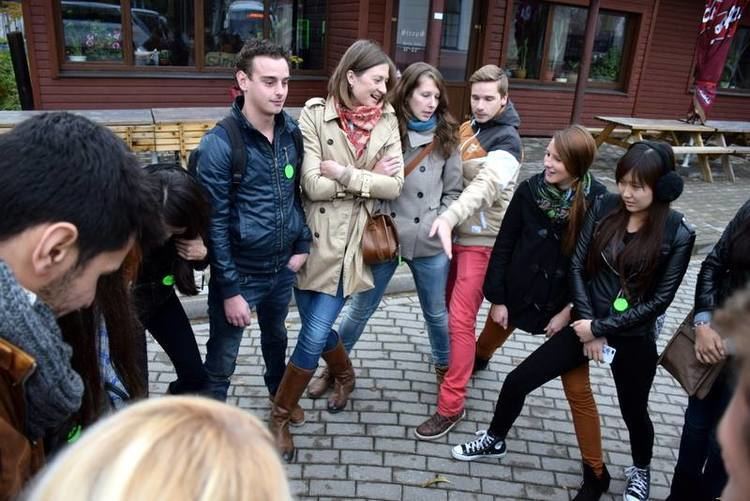Country Area 18.18 km2 Mayor Inesis Bokis | District Valmiera District Population 27,569 | |
 | ||
Map of Valmiera
Valmiera ( pronunciation ; German: Wolmar; Polish: Wolmar see other names) is the largest city of the historical Vidzeme region, Latvia, with a total area of 18.1 square kilometres (7 square miles). As of 2002, Valmiera had a population of 27,323, and in 2017 – 24,818.
Contents
- Map of Valmiera
- Valmiera city latvia
- Latvia valmiera
- Names and etymology
- History
- Today
- Sports
- Twin towns sister cities
- References

Valmiera lies at the crossroads of several important roads, 100 kilometres (62 miles) to the north-east from Riga, the capital of Latvia, and 50 km (31 mi) south of the border with Estonia. Valmiera lies on both banks of the Gauja River.

Valmiera city latvia
Latvia valmiera
Names and etymology
The name was derived from the Old German given name Waldemar or the Slavic name Vladimir. The town may have been named after the kniaz of the Principality of Pskov Vladimir Mstislavich who became a vassal of Albert of Riga in 1212 and for a short time was a vogt of Tālava, Ydumea and Autīne. Another version, it may have been named after the King of Denmark Valdemar II who allied with the Livonian Brothers of the Sword in Livonian Crusade. In the second half of 13th century Livonian Order built a castle which they called Wolmar in German. During the Livonian War the town was known in Russian as Володимерец (Volodimirec), but during the period of the Russian Empire it was known as Вольмар.
History
Valmiera and its surroundings have been one of the longest-inhabited regions of Latvia. Archeological evidence indicates the site was inhabited 9,000 years ago. In 1224 after partition of Tālava trade roads along the Gauja river became property of Livonian Brothers of the Sword who erected a castle which is today known as Valmiera Castle. After the Battle of Saule in 1236 Valmiera Castle and nearby lands became the property of the newly established Livonian Order.
Valmiera was first mentioned as a town in a chronicle dating back to 1323. The actual founding of the town probably occurred at least 40 years earlier when the master of the Livonian Order Wilken von Endorp constructed a castle (Wolmar) and Catholic church on the banks of the river Gauja. Valmiera was a member of the Hanseatic League from the 14th–16th centuries. Involvement in the Hansa brought significant trade and movement into the town’s life. During the 14th-16th centuries several regional assemblies (landtags) were held in Valmiera. After the Livonian War in 1583 Valmiera was heavily devastated and was incorporated into the Duchy of Livonia as part of Wenden Voivodeship. After the Polish-Swedish war in 1622 Valmiera was managed by the Lord High Chancellor of Sweden Axel Oxenstierna.
During the Great Northern War Valmiera was again destroyed and burned down in 1702. It was further devastated by plague. During the first half of the 18th century Valmiera was on the decline. In 1738 M.E. von Hallart opened the first seminary of the Moravian Church in Valmiera, a movement which played an important role in the history of Vidzeme. In 1785 Valmiera became the centre of a district. The town saw rapid development in the 19th century. First it was stimulated by the building of the first bridge over the river Gauja in 1865. Later the building of the Riga-St.Petersburg railway line through the town in 1899 also played a major role. Many new factories were built in the town and new settlements were growing on both banks of the river Gauja. During 1911-12 a narrow gauge railway line Ainaži-Valmiera-Smiltene was built thus making Valmiera a major transport hub. In 1906 Municipal elections were held and Valmiera was one of the few towns in Latvia where Latvians won the majority of seats (18 of 24). As a result, local doctor Georgs Apinis was elected as mayor. During the first quarter of the 20th century Valmiera also became a centre of culture and education as many schools were opened in the town. Among them were the Vidzeme teachers seminary, women gymnasium and merchant school.
During World War II, Valmiera was captured by troops of the German Army Group North on 4 July 1941 and placed under the administration of Reichskommissariat Ostland. The city was recaptured on 24 September 1944 by troops of the 3rd Baltic Front of the Red Army during the Riga Offensive. During the war almost all buildings at the center of Valmiera was destroyed.
The Cold War Liepas air base was located nearby.
Version 2.2 of the open source mapping application QGIS was named in honor of Valmiera.
Today
Valmiera is the de facto cultural and administrative centre of Vidzeme. It is the only town in the region to have a professional theater, Valmieras teātris, which was established in 1919. In 1996, Vidzeme University of Applied Sciences (Vidzemes Augstskola), was established.
Valmiera's municipality has been involved a variety of projects to improve the quality of life in the region. One of the largest projects is creating a garbage control system in northern Vidzeme. A project for water supply development and the restoration of sewage systems is being realised to promote the modernisation of the economic system in Vidzeme. The improvement of the payment system, the construction of a thermoelectric station, and the building of a sports hall for the Olympic Centre are also being planned.
Valmiera is an important industrial centre. The dominating economic branches in Valmiera are the food industry (milk, meat, and grain), fibreglass production, metalworking, wood processing and furniture producing.
Sports
Valmiera is a home to BK Valmiera, a basketball team that became champions of Latvian League in 2015–16 season.
Twin towns — sister cities
Valmiera is twinned with:
